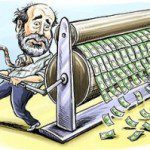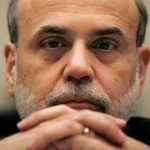Fearing that the flow of nourishing mother milk from the Fed could dry up, a  resolutely unweaned Wall Street threw a hissy fit and the dummy out of the pram last Thursday. The end of QE is seen as the beginning of the end of super-easy policy and potentially the first towards normalization. There is only one problem: it won’t happen. Here’s why.
resolutely unweaned Wall Street threw a hissy fit and the dummy out of the pram last Thursday. The end of QE is seen as the beginning of the end of super-easy policy and potentially the first towards normalization. There is only one problem: it won’t happen. Here’s why.
[The following article is presented by Lorimer Wilson, editor of www.munKNEE.com and may have been edited ([ ]), abridged (…) and/or reformatted (some sub-titles and bold/italics emphases) for the sake of clarity and brevity to ensure a fast and easy read. This paragraph must be included in any article re-posting to avoid copyright infringement.]
Schlichter goes on to say in further edited excerpts:
A new meme is spreading in financial markets: The Fed is about to turn off the monetary spigot.
- US Printmaster General Ben Bernanke announced that he might start reducing the monthly debt monetization program, called ‘quantitative easing’ (QE), as early as the autumn of 2013, and maybe stop it entirely by the middle of next year.
- He reassured markets that the Fed would keep the key policy rate (the Fed Funds rate) at near zero all the way into 2015.
Still, the end of QE is seen as the beginning of the end of super-easy policy and potentially the first towards normalization, as if anybody still had any idea of what ‘normal’ was. So far, so good. There is only one problem: it won’t happen.
Now I am the first to declare that the Fed SHOULD abolish QE, and not only in the autumn of this year or the summer of next, but right now. Pronto. Why? Because a policy of QE and zero interest rates is complete madness. It:
- distorts markets,
- sabotages the liquidation of imbalances,
- prohibits the correct pricing of risk,
- encourages renewed debt accumulation and
- numbs the market’s healing powers
by enabling more ‘pretend and extend’ in the financial industry – and it adds new imbalances to the old ones that it also helps to maintain. This policy may have prevented – for now – debt deflation but maybe debt deflation is what is needed.
QE is nothing but heavy-handed market intervention. It is destructive. It doesn’t solve the underlying problems. It creates new ones. None of these objections even register at the Fed, however. The Fed has a completely different perspective: This policy was a roaring success and as it has worked so well it can now be faded out. Soon there will be no need for it. Larry Summer’s dreadful phrase captures that thinking probably best: The economy will soon have achieved ‘escape velocity’.
Most analogies are somewhat poor but this one is particularly inept. Ironically, though, the reference to mechanics captures beautifully the logic of Keynesians and other interventionists: the economy is like a physical object moving through space and is occasionally in need of a little push to get moving again at an appropriate speed. Policy provides the push.
Bernanke doesn’t use these terms but his thinking is similar. He explained QE to the American public in 2010 by announcing that his job was to occasionally manipulate interest rates and asset prices to encourage lending, borrowing, spending, shopping, and other healthy economic activities, and that once his machinations had stimulated enough of those activities, the economy would again enter a virtuous cycle (his words) of self-sustained growth. Escape velocity has been restored. I think this is nonsense – however appealing it may sound to many laypersons.
The economy is NOT:
- an object that needs a push,
- a machine that needs to be jump-started,
- a lazy mule that needs a gentle slap on its behind to get going again…
The economy IS:
- a complex process of coordination,
- an elaborate tool that allows an extensive and diverse group of actors with different and frequently conflicting goals and interests to co-operate with one another peacefully toward the best possible realization of their own material aims.
A crisis is a failure of that coordination process. It is a cluster of errors. The only explanation for the occurrence of such a cluster of errors is a systematic distortion of the market’s coordinating properties, such as occurs when monetary expansion distorts interest rates and other relative prices, and leads to imbalances that unhinge the economy.
The economy went into recession because of massive financial deformations. Easy money had led to excessive indebtedness, a housing bubble and dangerous levels of leverage. The problems were such distortions, not lack of momentum. The real question is not whether the GDP statistics exhibit the right velocity but if the underlying dislocations – which, to the chagrin of the econometricians, cannot be easily ascertained from the macro-data – have now dissolved.
No Escape
The Fed believes:
- it has healed an economy that was sick from easy money with more easy money. The patient is feeling better and can soon be released from intensive care.
In my view:
- the patient is still sick and now suffers from a dangerous addiction to boot.
- The ‘feeling-better’ bit maybe, just maybe, [is] a lingering drug high from Dr. Bernanke’s generous medication.
- Withdrawal symptoms may surface soon. If they do, Dr. Bernanke will simply open the medicine cupboard again. Don’t forget, only a few weeks ago the man appeared on TV and tried to talk up the Russell 3000 stock index.
I do not doubt that, if measured by overall GDP, the US economy is presently doing better. I would be foolish to take on the Fed on this point. The Fed has a staff of 200-plus economists, most of them, I assume, from America’s finest universities, which doesn’t mean they are good economists but at any rate probably good statisticians. If they say there are signs of life in the economy, that’s good enough for me.
Where I disagree is on the narrative. The deformations are largely still there. How can they not, given the enormous policy effort to suppress the very market forces that would – in a free market – have exposed and liquidated these deformations? They are still visible, among other indicators, in high degrees of indebtedness and they matter. That is why I am distrustful of the Fed’s projections. Their theories compel them to believe in virtuous cycles and ‘escape velocity’ and to disregard imbalances and distortions. Any sustained removal of super-easy money will allow these deformations to resurface and immediately cloud the near term cyclical outlook. According to my worldview, this should be allowed to happen as it is part of the essential healing process, but it runs counter to the Fed’s worldview and the Fed’s view of its own mission.
The one institution that lacks ‘escape velocity’ is the Fed. It will remain hostage to the financial monsters it created and the dangerous misconception of its own grandeur.
[Editor’s Note: The author’s views and conclusions in the above article are unaltered and no personal comments have been included to maintain the integrity of the original post. Furthermore, the views, conclusions and any recommendations offered in this article are not to be construed as an endorsement of such by the editor.]
*http://detlevschlichter.com/2013/06/end-of-qe-i-dont-buy-it/ (© 2011 Detlev)
Related Articles:
1. What Will Happen When the Fed Finally Ends Its Extreme Easing Efforts?
Last Wednesday, Fed Chairman Ben Bernanke promised to end his bond-buying addiction – cold turkey – in mid-2014. That is, as long as the economy is strong enough. As a result, investor fortitude was pushed to the brink. Stocks sold off hard, sending the S&P 500 Index down 1.4%. Before you head for the exits, too, let’s get a little perspective. Read More »
 munKNEE.com Your Key to Making Money
munKNEE.com Your Key to Making Money

The real problem is the huge difference between what the banks get their money for and what the Banks charge US for that same money! That is what is killing the middle Class.
The Middle income Americans are being raped by the Big Banks who are keeping interest rates too high, since they are getting their Fed money at almost zero interest…
Our Leaders are enabling the Big Banks and that needs to stop, if America is going to turn this economy around! I think of this as a monetary squeeze of epic proportions.
+
Where are the 2.5% home loans?
Where are the 1.5% refinance rates?
Where are all the homes that the Banks now own, yet are not on the market?
Why are the Banks doing so well while we suffer so much?
http://bigstory.ap.org/article/us-banks-report-record-earnings-403b-q1